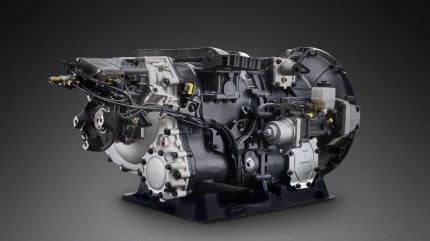
Scania’s has integrated reused components on its main assembly line in Sweden.
The achievement took place earlier this year as part of the iReGear joint research project with KTH Royal Institute of Technology and Scandinavian Transmission Service AB, and was made possible with funding from Vinnova, the Swedish innovation agency.

Discover B2B Marketing That Performs
Combine business intelligence and editorial excellence to reach engaged professionals across 36 leading media platforms.
The company said the ‘remanufactured’ gearbox was subject to exactly the same rigorous steps and inline quality and function tests as gearboxes that are made from entirely new parts. It was assessed on the same test rig used for new ones, with monitoring of some 100 quality and function parameters.
The gearbox duly met all those requirements, Scania said.
As well as the remanufactured gearbox being ‘as good as new’, the actual production process also brought environmental benefits. While replacement rates during gearbox remanufacturing can vary between roughly 10 percent to 100 percent depending on wear-and-tear history, this particular gearbox consumed approximately 50 percent less material and caused 45 percent fewer carbon emissions compared with gearboxes made only with new components.
Remanufacturing, which sees the reuse of old parts to create new products with as-good-as-new quality, is viewed by the automotive industry as a promising strategy for achieving climate goals and supporting the transition towards a circular economy. It also addresses increasing resource scarcity issues.
In spite of its great potential, remanufacturing in the European automotive sector is mainly confined to making spare parts for aftermarkets, which account for only 1.1 percent of new manufacturing according to the report by the European Remanufacturing Network (2015).
The wider adoption of the process requires vehicle manufacturers to integrate the remanufactured components directly into the production lines of new vehicles, rather than using them separately in sales to the aftermarket business.
Scania said it is hoped that the pioneering iReGear project will help lead the way for the industry to make this necessary shift in the efforts to create a more sustainable and cleaner transport industry.
“What an achievement by the project and everyone involved. This remanufactured gearbox is a compelling example of how the manufacturing of heavy vehicles can become more sustainable, circular and efficient, while still retaining the highest quality standards,” says Fredrik Nilzén, Head of Sustainability at Scania.
“This research provides the first evidence to support the argument that it is feasible to envision future manufacturing organisations seamlessly integrating manufacturing and remanufacturing operations to develop Circular Manufacturing Systems that consume fewer resources, produce fewer emissions, and cost less without compromising quality and performance”, says Farazee Asif, Assistant Professor at KTH.
“STS has been remanufacturing gearboxes for more than 50 years. It’s amazing to be able to challenge the old perception that remanufactured parts only can be used for aftermarket purposes. Today, we can proudly reflect on a period of successful collaboration, where we have achieved breakthroughs in sustainable technology. This project truly shows that it might not need to stop at just one idea, but it could become a reality in the near future,” says Ola Stålebo, CEO, Scandinavian Transmission Service AB.






